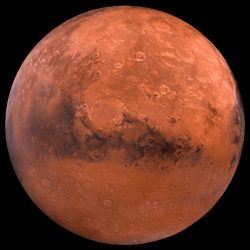
NASA reported that a cloud of dust was surrounding Mars high above its atmosphere. The authors of the study ruled out Mars itself and its moons Phobos and Deimos as the sources of the dust and concluded that it must come from a larger dust cloud floating around between the planets in our solar system.
This “interplanetary dust” is hugely important. It is thought to have played a crucial role in the formation and evolution of our solar system. What’s more, it may even have provided our planet with water, and kick-started life.
Our solar system formed from the collapse of a hydrogen and helium gas cloud mixed with dust, otherwise there would not be any rocky planets like Earth and Mars. The fact that Earth contains such heavy elements as gold, lead, or uranium (all heavier than iron) shows that our sun is a third or higher-generation star, preceded by at least one supernova explosion of another nearby star.
Interstellar dust particles, which predate our own solar system, can provide insight into the processes at the end of the lifetime of ancient stars. The interplanetary dust in the inner solar system contains some interstellar dust particles. But the vast majority of interplanetary dust particles in our solar system are released from comets as they approach the sun or from the collision of asteroids in the asteroid belt.
They therefore contain clues about the makeup and formation of such “proto-planets”, which are seen as the first steps of planet formation from the huge dust and gas cloud surrounding a new star.
Any cosmic dust mineral grain offers a surface for gases, ice or organic matter to stick to. Complex molecules of organic matter as the basic building blocks for life have been documented in intergalactic dust clouds, comets and meteorites.
Understanding the distribution and amount of dust is important because dust could have delivered significant amounts of water and organic matter to the planets in the inner solar system, in particular Earth and Mars. While many researchers think that asteroid and comet impacts may be behind the water and life on Earth, several studies have indicated that dust itself can deliver water and organic matter simultaneously and might have jump-started life. This process would work universally, also on exoplanets in distant solar systems.
So if the dust did jump start life on Earth it is plausible that it could have done so on Mars as well. However, Earth’s magnetic field has protected our atmosphere and water against being destroyed by the solar wind, we get just the right amount of it. Mars has not had a magnetic field for most of its lifetime, and its atmosphere and water have subsequently been lost to space.
Without water, organic matter molecules cannot be assembled into the very complex molecules, like DNA and proteins, that make up life. Lack of a thick atmospheric layer also means lack of protection against destruction of organic molecules by UV light and other harmful forms of cosmic radiation. While the jury is still out on whether there was ever life on Mars, it is extremely unlikely that dust could jump start life on Mars today, despite hovering above its atmosphere.
It is obviously important that we learn more about dust. Interplanetary dust particles are actively collected for research by sending planes into the stratosphere or scouring spacecraft returning to land for impacts of these tiny dust particles. If dust particles make it to the ground by themselves, they can be collected as micrometeorites from places where they are recognisable such as ocean or polar sediments.
However, once an interplanetary dust particle enters the Earth’s atmosphere or smashes into a spacecraft, any complex molecules stuck to it are inevitably lost. While we can learn a lot from them about the primordial matter from which our solar system formed as well as the makeup of comets and asteroids, we have to investigate these bodies first-hand to be able to obtain more sensitive information.
A good way to do this is to fly through comet tails. This is what Rosetta did to make the surprise discovery of free oxygen in the coma of comet 67P/Chryumov-Gerasimenko. Meanwhile, NASA’s Stardust mission flew through the tail of comet Wild 2 and returned cosmic dust particles to Earth for analysis in 2006. In 2009, NASA announced that fundamental chemical building blocks of life had been found: glycine, an amino acid.
Additional data like this can hopefully help uncover many more secrets of the dust in the universe, including whether it kick-started life on Earth and whether it could do it again.
